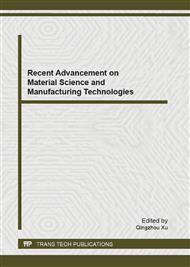p.139
p.144
p.148
p.153
p.159
p.164
p.169
p.173
p.177
The Investigation of a New NO2 OTFT Sensor Based on Heterojunction F16CuPc/CuPc Thin Films
Abstract:
The bottom contact heterojunction organic thin film transistors (OTFTs) based on n-type hexadecafluorophthalocyaninatocopper (F16CuPc) and p-type copper phthalocyanine (CuPc) bilayer were developed by the vacuum evaporation, which were applied to detect nitrogen dioxide (NO2). The sensors with different thickness (5nm, 10nm, 15nm and 20nm) of CuPc were prepared to investigate the influence of CuPc film thickness on the properties of devices. The results showed that four parameters including the source-drain current (IDS), grid current (IGS), threshold voltage (VT) and carrier mobility (μ) changed in a few seconds when the sensors were exposed to the atmosphere of NO2. Further more, IDS and IGS presented extremely similar variation trend. So the grid current would be taken as a new parameter to reveal the response characteristic of OTFT gas sensor. By comparison, the device with 15nm CuPc thin film exhibited the optimum electronic and gas sensing properties.
Info:
Periodical:
Pages:
159-163
Citation:
Online since:
July 2013
Authors:
Keywords:
Price:
Сopyright:
© 2013 Trans Tech Publications Ltd. All Rights Reserved
Share:
Citation:


